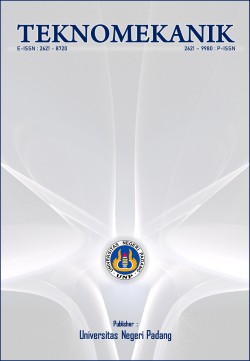The development of e-module based on learning models of self directed learning in welding subject
DOI:
https://doi.org/10.24036/jptk.v4i2.16923Keywords:
E-Module, Validity, Practical, Effectiveness, Self Directed LearningAbstract
This study aimed to produce an e-module based on a self-directed learning model that was valid, practical and effective and was able to help students learn independently and understand SMAW manual arc welding theory. This study is a Reset and Development (R&D) study which refers to the ADDIE instructional development model. ADDIE development procedures namely Analysis, Design, Develop, Implementation and Evaluation. The results of this Research and Development produced a valid learning e-module based on the evaluation of material expert validators who declared valid and the material expert validators who declared valid. The practicality of using e-module was known from the use of e-module that going well and the results of students and teachers responses from questionnaire statements were high practicality. The results of the effectiveness were known from the increase in the students' understanding of subject and the test results of the difference between pre-test and post-test results of the application of this e-module were quite effective category. Based on this study, a learning e-module for SMAW Manual Arc Welding based on the Self Directed Learning model had produced. this was valid, practical and effective for use in learning and can improve the theoretical understanding of SMAW Manual Arc Welding subject.
Downloads
References
Arsyad, Azhar. (2016). Media Pembelajaran. Jakarta: Raja Grafindo Persada.
Arief Sadiman dkk. (2014). Media Pendidikan.Jakarta : Raja Grafindo Persada
Asep Herry Hernawan. (2012). Pembelajaran Terpadu. Jakarta: Diretorat Jenderal Pendidikan Islam Departemen Agama RI
Azwar, Saifuddin. (2014).Metode Penelitian. Yogyakarta: Pustaka Pelajar.
BSNP. (2010). Paradigma Pendidikan Nasional Abad XXI. [Online]. Tersedia: http://www.bsnp-indonesia.org/id/wp-content/uploads/2012/04/Laporan-BSNP-2010.pdf.
Dimyati.(2013).Belajar dan Pembelajaran .Jakarta:Rineka CIPTA
Daryanto, dan Rachman, A. (2014). Pengembangan Perangkat Pembelajaran.Yogyakarta: GAVA MEDIA.
Harsono, Rahayu, G. R. (2016). Faktor-faktor yang mempengaruhi self directed learning readiness pada mahasiswa tahun pertama, kedua dan ketiga di Fakultas Kedokteran.Jurnal Pendidikan Kedokteran Indonesia. Vol.5 67-77
Hake, R. R. (1999). Analyzing Change/Gain Values. Artikel.www.physics.indiana.edu/~sdi/AnalyzingChange-Gain.pdf.
I Diansah, A Asyhari2 (2020). Effectiveness of physics electronic modules based on Self Directed Learning Model (SDL) towards the understanding of dynamic fluid concept. IOPsciense. J. Phys .: Conf. Ser. 1572 012024
Juliansyah Noor. (2013), Metodelogi Penelitian .Jakarta: Kencana
Prastowo, Andi. (2011). Panduan Kreatif Membuat Bahan Ajar Inovasi. Yogyakarta: DIVA Press.
Sudjana, Nana. (2013). Dasar-Dasar Proses Belajar Mengajar. Bandung: Sinar Baru Algensindo.
Sofyan, (2010), Proses Pembelajaran Inovatif dan Kreatif Dalam Kelas, Metode, Landasan Teoritis, Praktis dan Penerapannya, Jakarta, Prestasi Pustaka.
Sugiyono. (2017). Metode Penelitian dan Pengembangan Research and Development. Bandung: Alfabeta.
Raiser, R.A & Dempsey, J.V. (2007). Trends and Issues in Instructional Designand Technology. Secon Edition. New Jersey: Pearson Merril Prentice Hall.
Downloads
Published
How to Cite
Issue
Section
License
Copyright (c) 2021 Anugrah Agung Ramadhan, Nizwardi Jalinus

This work is licensed under a Creative Commons Attribution 4.0 International License.





